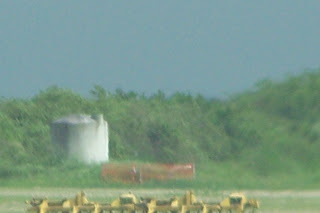Over the long weekend, ABE graduate students Isaya and Tanh trekked from Gainesville to south Florida to take soil core samples and install tensiometers at the C-111 Project research sites.
 Installing tensiometers
Installing tensiometersFollowing some preparation in the lab, a tensiometer is ready for installation. The installation process first requires preparing the install site for the instrument. In our case, this is done by hammering a large nail of similar diameter to a desired depth based on the length of the tensiometer.


Site preparation is followed by sieving site soil to prepare a slurry that works as a bonding agent to enhance instrument contact with the soil.



Tensiometers measure soil water potential. Installing these devices in close proximity to the soil water content probes will complement the probe data with easily accessible soil water status information. A total of 12 tensiometers were installed this weekend (2 per site). Tensiometer data will be recorded during research site downloading visits.
Soil core sampling

Soil core sampling was detailed in a previous post by Isaya: http://abewaterfountain.blogspot.com/2010/07/c-111-project.html
.JPG)
.JPG)
.JPG)
.JPG)

.JPG)


























